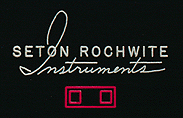
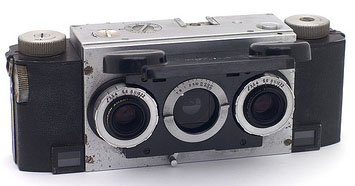
SETON ROCHWITE, FPSA
November 22, 1904 - July 18,
2000
Inventor of the Stereo Realist
camera
--------------
Some remembrances and history
by Susan Pinsky, APSA & David Starkman, APSA
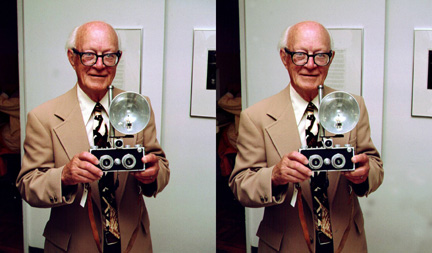 Seton Rochwite, the inventor of the Stereo Realist camera, passed away on
July 18, 2000, having almost reached the age of 96. We found this out almost a
month later, at the August meeting of the Stereo Club of Southern California.
Part of the program for the evening was a "Stereo Fair" (a show-and-tell of
sorts) and one of the items that we happened to bring with us was a "Stereo 50"
-- a 50 slide sequential viewer. Just because it was interesting we decided to
bring one that we had filled with 50 slides of Seton that we, and others, had
taken, since we first met him at the Photographic Society of American (PSA)
Annual Convention in 1978 held in Denver, Colorado.
Seton Rochwite, the inventor of the Stereo Realist camera, passed away on
July 18, 2000, having almost reached the age of 96. We found this out almost a
month later, at the August meeting of the Stereo Club of Southern California.
Part of the program for the evening was a "Stereo Fair" (a show-and-tell of
sorts) and one of the items that we happened to bring with us was a "Stereo 50"
-- a 50 slide sequential viewer. Just because it was interesting we decided to
bring one that we had filled with 50 slides of Seton that we, and others, had
taken, since we first met him at the Photographic Society of American (PSA)
Annual Convention in 1978 held in Denver, Colorado.
1. The Man Behind the 1950's 3-D boom: Seton Rochwite was the originator of
the five-sprocket stereo system.
Here he is holding the original prototype of
the camera which became the Stereo Realist. (Stereophoto by
David
Hutchison)
When we first met Seton we were in our first year of publishing "Reel 3-D
News". Having already done a lot of research in 1950's magazines,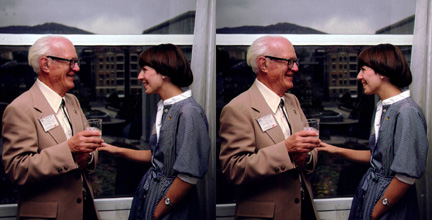 we were amazed
that the inventor of a camera introduced to the world in 1947 was still alive --
and very active as an award winning stereo photographer. We were both in our
late 20's, so 74 seemed "older" to us at the time. We had no way of knowing then
that we would continue to know Seton, to see him almost every year, and exchange
Christmas cards for another 22 years!
we were amazed
that the inventor of a camera introduced to the world in 1947 was still alive --
and very active as an award winning stereo photographer. We were both in our
late 20's, so 74 seemed "older" to us at the time. We had no way of knowing then
that we would continue to know Seton, to see him almost every year, and exchange
Christmas cards for another 22 years!
Christmas Card from Seton & Isabelle - 1981
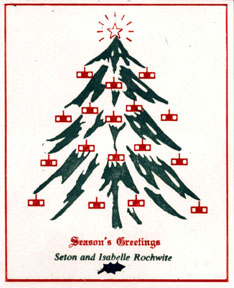
2. Seton Rochwite & Susan Pinsky at Salt Lake City PSA Convention in
1981.
(photo by David Starkman)
Seton enjoyed our young interest and enthusiasm in stereo, and, from the
beginning was encouraging and always forthcoming to us with suggestions and
information about 3-D. Thanks to the encouragement of Seton and many other "old
timers" we got quite involved with PSA and the PSA competitions, to the point
where Seton was one of our endorsers to receive the honor of APSA -- Associate
of the Photographic Society of America. However, that's another story.
The story of the Stereo Realist camera is unusual in many ways. The main
point being that it was not commissioned to be designed by a major camera
company, after a time of great research and development. It was based on the
third stereo camera that Seton had built for himself for his own stereoscopic
hobby. All of the key aspects of the camera, viewer, and slide mount were
designed by just one man. And by the mid 1950's over 40 brands of stereo cameras
were on the market, copying this same format. HE was the man and this was the
3-D camera responsible for the stereo boom of the 1950's.
In 1979 we did an article for "Reel 3-D News" on the history of Seton
Rochwite, and the cameras that he developed. We did this partly to share the
history that Seton had shared with us, and partly to honor him as the recipient
of the Progress Medal Award at the annual Convention of the Photographic Society
of America (PSA) held at Hartford, Connecticut in October 1979.

Following are some updated excerpts from what we had written:Rochwite had been interested in stereo photography since 1929, and in
photography in general, since he was 12 years of age. There is no doubt that he
has been one of the great contributors to the art and science of photography.
Seton's outstanding contribution to photography was the invention of the
Stereo Realist camera. Prior to World War II, stereo photography had been
limited to larger format cameras, and because of the sheer size and/or bulk were
of limited scope. It was the advent of color film in the 35mm size in 1936 that
created the opportunity for the introduction of an appropriate 35mm format
stereo camera.
Seton was a lighting engineer at what is now the Wisconsin Electric Power
Company. "I first saw 3-D pictures in 1929 when I did some photofinishing for my
boss, Irving Illing. As soon as I viewed his black and white glass stereo
slides, other types of photography lost their appeal to me."
Seton
built his first stereo camera in 1930. It was made up, essentially, of parts
from a pair of Kodak box cameras. It took adequate pictures in black-and-white.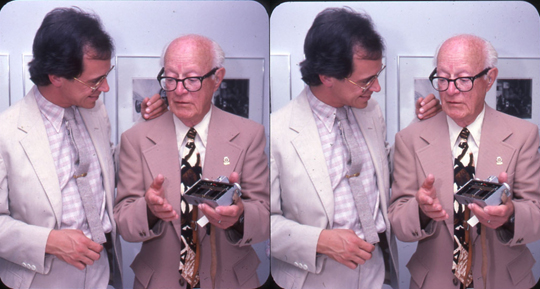 Better cameras of American and German manufacture could be purchased at that
time. Seton elected to make his own, probably as much for the fun of designing
and building it, as for enjoying its use later on. His second camera, built in
1932, was of all-metal construction and used a pair of 50mm Certar f/4.5 lenses
in Vario shutters with interlocked focusing and aperture adjustments. Neither
of these cameras was particularly significant in itself. The self-assigned
task of designing and building them gave Seton the experience and confidence to
go ahead when the time was right for a third experiment.
Better cameras of American and German manufacture could be purchased at that
time. Seton elected to make his own, probably as much for the fun of designing
and building it, as for enjoying its use later on. His second camera, built in
1932, was of all-metal construction and used a pair of 50mm Certar f/4.5 lenses
in Vario shutters with interlocked focusing and aperture adjustments. Neither
of these cameras was particularly significant in itself. The self-assigned
task of designing and building them gave Seton the experience and confidence to
go ahead when the time was right for a third experiment.
When Kodachrome was introduced in 1936 (in 35mm format in 1938) Seton was
quick to visualize its significance in connection with stereo. Here was a
natural marriage- a chance to combine the inherent realism of color with
stereo's built-in depth effect. He assumed that the big camera manufacturers
would see it the same way. He waited for them to bring out the ideal stereo
outfit - a camera designed to use 35mm Kodachrome. He waited, but nothing
happened.
Nothing kept on happening.
Seton finally decided that, if he wanted his dream camera he would have to
build it himself. He started shopping around for a pair of used cameras to
provide parts and lenses, meanwhile wondering what would be the best picture
size to use. The combination he came up with became the standard of the stereo
field in the 1950's. He selected a pair of Univex Mercury cameras with 35mm
Wollensak Tricor f/3.5 lenses that had been worth $25 each, new, in 1938. That's
where the 35mm focal length of modern stereo camera lenses came from.
He chose the 5-perforation-wide picture on 35mm film as a most economical
size, one his lenses would cover well, and a most convenient size for which to
design a stereo film transport system. He did not remember if he had seen the
film transport progression that had been invented by Colardeau in the 35mm
Homeos camera of Jules Richard, but he essentially updated that same idea from a
4 sprocket to 5 sprocket (square) film format. This allowed for a 70mm lens
separation, with half of two frames available between each stereo pair. This
created virtually no wasted film, and allowed for 28 or 29 stereo pairs on a 36
exposure length of 35mm film. That's the source of the Realist stereo-picture
format.
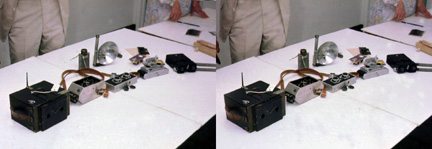
3. Cameras & viewer built by Seton Rochwite. All were donated to the
California Museum of Photography in Riverside, California in April 1985. Left to
Right: Seton's first Stereo camera, 1930, made from two Kodak box cameras. All
metal camera constructed from two vest pocket Dolly cameras, 1932. The 35mm
camera made in 1940 from two Univex Mercury cameras. It became the basis for the
Stereo Realist. The plated solid brass prototype for the Kin-Dar Stereo camera,
1950's. The prototype for the Stereo Realist Red Button viewer, 1940's.
(Stereophoto by David Starkman)
The camera was finished in 1940, along with its companion viewer. Seton's
first slides had to be mounted for viewing, and the most convenient glass for
him to use came in 3 1/4 x 4 inch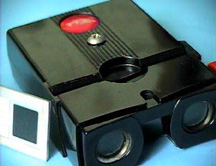 lantern-slide plates. Cutting one in half gave
him two pieces 1 5/8 x 4 inches, which is the over-all size of the
Realist-format standard stereo mount. Thus, most of the basic elements of modern
stereo evolved, not in a big research laboratory, but in an amateur's home
workshop. The David White Company of Milwaukee became interested, but the war
intervened, and it was not until 1947 that Seton's camera was placed on the
market as the Stereo Realist, which started the 1950's stereo boom, which
continues to this day.
lantern-slide plates. Cutting one in half gave
him two pieces 1 5/8 x 4 inches, which is the over-all size of the
Realist-format standard stereo mount. Thus, most of the basic elements of modern
stereo evolved, not in a big research laboratory, but in an amateur's home
workshop. The David White Company of Milwaukee became interested, but the war
intervened, and it was not until 1947 that Seton's camera was placed on the
market as the Stereo Realist, which started the 1950's stereo boom, which
continues to this day.
4. The Stereo Realist spawned a complete line of products and accessories.
(Stereophoto courtesy of Reel 3-D Enterprises, Inc.)
Upon Illing's encouragement, Seton took his camera
to the David White Company. The Milwaukee firm, founded in 1900, specialized in
the production and sale of precision optical instruments. Seeking new products
to replace those they had produced during the war, David White bought Seton's
designs for the camera, viewer and home mounting kit. Seton then joined the
company in 1943.
During the years 1943-47 Seton designed and developed the Stereo Realist
camera, including giving it its most descriptive name and logo design. The
camera and its companion slide viewer appeared on the American market during the
summer of 1947. By the middle of the 1950's Kodak, Revere, Graflex and TDC
followed suit with their own cameras.
Later on Seton developed the Kin-Dar attachment for the Exacta camera,
permitting close-up photography in 3-dimensions of small moving objects at a
distance of 3 to 13 inches, which, in itself, is an outstanding contribution
The Kin-Dar camera was an assignment by Kin-Dar Corporation of South
Milwaukee to design a camera that would take good stereo pictures with a minimum
of effort and could be made to sell for less than $100. The Kin-Dar camera
resulted, with a price tag of $99.50. It retains some unusual features similar
to those of the Realist, like a left-hand shutter-release button and viewfinder
window placed at the bottom of the camera. Other details are entirely different
- it is focused by a large knob at the top center of the camera, which moves the
lens board in and out instead of shifting the film within the camera. A single
window at the back of the camera serves the dual purpose of rangefinder and
viewfinder.
Perhaps the most beautifully designed stereo camera is the almost-unknown
Contura, which Seton designed for Stereo Corporation in Milwaukee. It resembled
the Stereo Realist, including the bottom rangefinder. The lenses and the
shutters appear to be of Ilex manufacture. It had a lens aperture of f/2.7 to
f/22. Shutter speeds B to 1/100. Rangefinder focusing. The shape, the center
knob, and saddle leather trim make it an unusually graceful camera in
appearance. Like the Stereo Realist and Kin-Dar it also had a left hand shutter
release button, although Seton was right handed. Seton designed the technical
details of the camera, but the sleek look of its design is due to the work of
the visual stylist Brooks Stevens, who designed racing boats, and later the
Excalibur automobile!
In the 1970's he developed the polarizing filter attachment for the Realist
camera, which proved of immeasurable value to stereo enthusiasts throughout the
world.
5. Rochwite in his workshop in Loveland, Colorado,
making part of the
polarizer attachment for the Stereo Realist camera.
(Stereophoto probably by
Isabelle Rochwite)
He applied for, and received, a patent on a new stereo system designed for
the mass market which was designed to make stereo photography almost as simple
as the popular 35mm itself. It was intended to use 16mm film, and would have
brought stereo photography to the masses in the same pocket size camera as 110
film, which was popular at that time.
The Progress Medal of the Photographic Society of America is awarded
annually to a person who has made an outstanding contribution to photography or
an allied subject. Seton Rochwite certainly fit that description.
We are grateful to Seton Rochwite for creating the camera(s) which made it
possible for all of the 3-D enthusiasts throughout the world to enjoy the many
fascinations of three-dimensional photography.
Information for this
article was compiled and reprinted from contributions by Joseph P. Fallon, Jr.,
"Stereo Today" by Robert L. McIntyre, "Seeing Double Two: The Stereo
Renaissance" by Steve Coppinger and Barbara Beniak, Greg Taylor at Stereo
Photography Unlimited, Three Dimensional Projection by Earl E. Krauss, and Susan
Pinsky's interviews with Seton.
6. Seton and Isabelle Rochwite at the Salt Lake City PSA Convention,
October 1981.
(Stereophoto by David Starkman)
The following is the text of the
obituary, sent by his daughter Susan Richardson, as it appeared in the Loveland
Reporter Herald, Denver Post and Casper Star Tribune.:
"Seton Rochwite, of Loveland, CO, a retired consulting product engineer,
died 7/18/00. He was 95. He was born November 22, 1904 in Princeton, Wisconsin. After the family
moved to Hartford, Wisconsin he attended Hartford High School. After his
graduation in 1924 he went on to Marquette University in Milwaukee, Wisconsin,
graduating in 1929 with a degree of Electrical Engineer. The first 14 years of
his career were as a lighting engineer with The Milwaukee Electric Co. In 1943
he designed a stereoscopic camera utilizing the newly announced Kodachrome Color
film. He named it the Stereo Realist and it caused a worldwide revival of
interest in stereo photography and is still the standard by which others are
judged. Two years of his career were spent as a staff member at the Los Alamos
Scientific Laboratory. Leaving there in 1952, he began a career as a consulting
product engineer in both the photo and medical instruments fields. In 1977 he
and his wife Isabelle left California where they had lived for 14 years and
moved back to Loveland to spend their retirement years. She preceded him in
death in 1995 shortly after they had celebrated their 69th wedding anniversary
and just 2 days before her 91st birthday.
For many years he was active in photo exhibitions worldwide receiving many
medals and honors. He had achieved the rating of Master 1 for having had over
755 acceptances with over 171 different pictures. In 1979 The Photographic
Society of America presented him with it's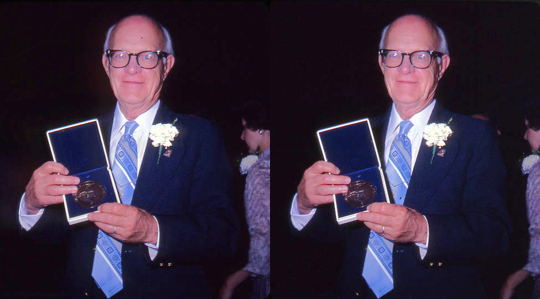 highest honor, The Progress Medal,
for his achievements in photographic equipment design. He was an honorary member
of three camera clubs - The Photo Pictorialissts of Milwaukee, The Oakland
Camera Club and the Rocky Mountain Camera Club. He was also a member of Tau
Beta Pi, national engineering honor fraternity.
highest honor, The Progress Medal,
for his achievements in photographic equipment design. He was an honorary member
of three camera clubs - The Photo Pictorialissts of Milwaukee, The Oakland
Camera Club and the Rocky Mountain Camera Club. He was also a member of Tau
Beta Pi, national engineering honor fraternity.
He is survived by two daughters - Sue Richardson of Casper, Wyoming and
Sally Kustka of Bowie, Maryland, six grandchildren and three great
grandchildren."
In a recent posting on the "Photo 3-D" mailing list, Allan Griffin, a
mutual friend, added these thoughts:
I remember well, way back in the early days, Seton had only just completed
his add-on "Realist Polariser" project. I was able to admire the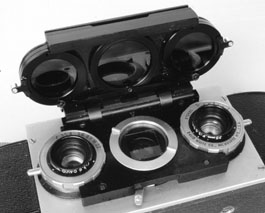 care and
attention to detail which went into the engineering and production. Even the
engraving which identified the three element attachment was done with infinite
care. On subsequent visits, after being offered one of his hallmark Dry
Martinis, I always had to go down to the basement and look over his complete and
most impressive small project workshop. Seton was a most organised person. His
stereo-slide filing system was a wonder to behold when compared with my own and
that of many others! I was able to discuss at length details concerning the
evolution of the Realist camera and the 4 X 1.5/8" Realist stereo slide format.
Seton said: "It was simple. I just took a 4" lantern slide of the time and cut
two slices off it of appropriate height"!
care and
attention to detail which went into the engineering and production. Even the
engraving which identified the three element attachment was done with infinite
care. On subsequent visits, after being offered one of his hallmark Dry
Martinis, I always had to go down to the basement and look over his complete and
most impressive small project workshop. Seton was a most organised person. His
stereo-slide filing system was a wonder to behold when compared with my own and
that of many others! I was able to discuss at length details concerning the
evolution of the Realist camera and the 4 X 1.5/8" Realist stereo slide format.
Seton said: "It was simple. I just took a 4" lantern slide of the time and cut
two slices off it of appropriate height"!
Prior to this and at the same
time, the makers of the French Verascope f-40 had settled for a 4.1/4" long 35mm
standard stereo slide. This was eventually dropped in favour of the Realist 4"
format because of the sheer volume of the Realist popularity. Seton never did
acknowledge that my Verascope f-40 or Belplasca 7 perf format was a nice format
in its own right and at one stage (25 years ago) he was visibly upset when he
learned that I was shooting sports and hypers with my Konica Twin FS-1s. He
seemed to feel let-down if folks were not shooting 5 perf Realist exclusively!
After I learned this, I never again raised the subject of anything in the realm
of wider formats but allowed the Realist to remain king in its realm, thus
ensuring the continuity of our long friendship!
As Ray Moxom
mentioned, it is indeed rare to find an inventor who stayed with one of his
inventions for life, enjoying the artistic and creative potential which it
introduced into his life. Further, Seton told me that the people who shot
stereo (mostly in the ranks of Stereo Division - PSA) turned out to be his
favourite people - people who proved to be those with whom he found a great deal
in common. The fact that he achieved Master Stereographer 1 level when more
acceptances were required than is the case today, speaks for itself. We were at
the ' 79 PSA event where Seton was awarded the Progress Medal for service to
photography in general - and in particular, stereo. His address to the PSAers
present was a highlight. With no notes, the address was from the heart, in
parts emotional and in total eminently memorable. The standing ovation was
prolonged and heartfelt.
To close, may I simply say that my life has
been the richer for knowing Seton Rochwite at the personal level as well as at
the level of competitive stereo photography. I'm sure he would forgive the
personal references above. It was a privilege to know him.
-- Allan
Griffin, Hon.PSA, Pymble, Australia
In April 1985, Seton and his wife Isabelle donated their vast
collection of prototype photographica, that he had created since the 1930's, to
the California Museum of Photography in Riverside, California. We were fortunate
to be on hand, along with NSA members David Hutchison, Nick Graver, and Ed
Earle, curator of the Keystone-Mast stereoview collection, to witness the
donation.
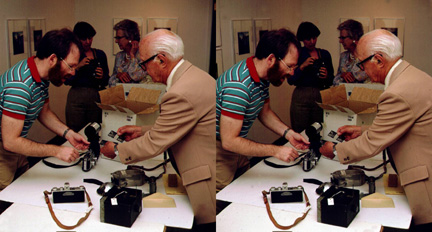
7. Seton shows David Starkman some of the items that were donated to the
California Museum of Photography. Susan Pinsky & Isabelle Rochwite are in
the background. (Stereophoto by
David Hutchison)
We feel privileged to have known Seton (and Isabelle, his wife of more than
60 years), and hope that we have been able to share just a little of the
incredible significance that this kind and gentle man has had on all of us who
enjoy the hobby of stereo photography today. We will miss Seton, but his spirit
and his images will live on, and beyond us, in full color 3-Dimensional
Kodachrome.
For more information on Seton and the 3-D history of his contributions see
"Stereo World" July/August 1988 "A Visit with Seton Rochwite" by Mark
Willke.
- Susan Pinsky and David Starkman, Culver City, California,
August 2000.
www.3-DLegends.com
Preserving
stereoscopic
history of extraordinary people who have enriched our lives |
| |
|


 Seton Rochwite, the inventor of the Stereo Realist camera, passed away on
July 18, 2000, having almost reached the age of 96. We found this out almost a
month later, at the August meeting of the Stereo Club of Southern California.
Part of the program for the evening was a "Stereo Fair" (a show-and-tell of
sorts) and one of the items that we happened to bring with us was a "Stereo 50"
-- a 50 slide sequential viewer. Just because it was interesting we decided to
bring one that we had filled with 50 slides of Seton that we, and others, had
taken, since we first met him at the Photographic Society of American (PSA)
Annual Convention in 1978 held in Denver, Colorado.
Seton Rochwite, the inventor of the Stereo Realist camera, passed away on
July 18, 2000, having almost reached the age of 96. We found this out almost a
month later, at the August meeting of the Stereo Club of Southern California.
Part of the program for the evening was a "Stereo Fair" (a show-and-tell of
sorts) and one of the items that we happened to bring with us was a "Stereo 50"
-- a 50 slide sequential viewer. Just because it was interesting we decided to
bring one that we had filled with 50 slides of Seton that we, and others, had
taken, since we first met him at the Photographic Society of American (PSA)
Annual Convention in 1978 held in Denver, Colorado. we were amazed
that the inventor of a camera introduced to the world in 1947 was still alive --
and very active as an award winning stereo photographer. We were both in our
late 20's, so 74 seemed "older" to us at the time. We had no way of knowing then
that we would continue to know Seton, to see him almost every year, and exchange
Christmas cards for another 22 years!
we were amazed
that the inventor of a camera introduced to the world in 1947 was still alive --
and very active as an award winning stereo photographer. We were both in our
late 20's, so 74 seemed "older" to us at the time. We had no way of knowing then
that we would continue to know Seton, to see him almost every year, and exchange
Christmas cards for another 22 years!

 Better cameras of American and German manufacture could be purchased at that
time. Seton elected to make his own, probably as much for the fun of designing
and building it, as for enjoying its use later on. His second camera, built in
1932, was of all-metal construction and used a pair of 50mm Certar f/4.5 lenses
in Vario shutters with interlocked focusing and aperture adjustments. Neither
of these cameras was particularly significant in itself. The self-assigned
task of designing and building them gave Seton the experience and confidence to
go ahead when the time was right for a third experiment.
Better cameras of American and German manufacture could be purchased at that
time. Seton elected to make his own, probably as much for the fun of designing
and building it, as for enjoying its use later on. His second camera, built in
1932, was of all-metal construction and used a pair of 50mm Certar f/4.5 lenses
in Vario shutters with interlocked focusing and aperture adjustments. Neither
of these cameras was particularly significant in itself. The self-assigned
task of designing and building them gave Seton the experience and confidence to
go ahead when the time was right for a third experiment. 
 lantern-slide plates. Cutting one in half gave
him two pieces 1 5/8 x 4 inches, which is the over-all size of the
Realist-format standard stereo mount. Thus, most of the basic elements of modern
stereo evolved, not in a big research laboratory, but in an amateur's home
workshop. The David White Company of Milwaukee became interested, but the war
intervened, and it was not until 1947 that Seton's camera was placed on the
market as the Stereo Realist, which started the 1950's stereo boom, which
continues to this day.
lantern-slide plates. Cutting one in half gave
him two pieces 1 5/8 x 4 inches, which is the over-all size of the
Realist-format standard stereo mount. Thus, most of the basic elements of modern
stereo evolved, not in a big research laboratory, but in an amateur's home
workshop. The David White Company of Milwaukee became interested, but the war
intervened, and it was not until 1947 that Seton's camera was placed on the
market as the Stereo Realist, which started the 1950's stereo boom, which
continues to this day. 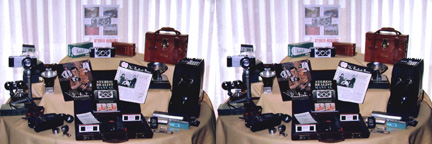
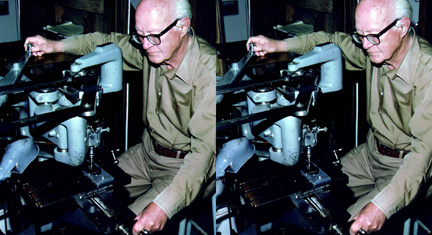
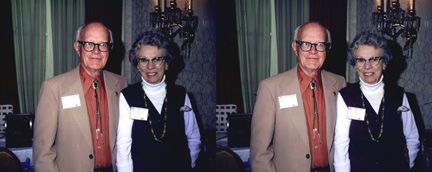
 highest honor, The Progress Medal,
for his achievements in photographic equipment design. He was an honorary member
of three camera clubs - The Photo Pictorialissts of Milwaukee, The Oakland
Camera Club and the Rocky Mountain Camera Club. He was also a member of Tau
Beta Pi, national engineering honor fraternity.
highest honor, The Progress Medal,
for his achievements in photographic equipment design. He was an honorary member
of three camera clubs - The Photo Pictorialissts of Milwaukee, The Oakland
Camera Club and the Rocky Mountain Camera Club. He was also a member of Tau
Beta Pi, national engineering honor fraternity. care and
attention to detail which went into the engineering and production. Even the
engraving which identified the three element attachment was done with infinite
care. On subsequent visits, after being offered one of his hallmark Dry
Martinis, I always had to go down to the basement and look over his complete and
most impressive small project workshop. Seton was a most organised person. His
stereo-slide filing system was a wonder to behold when compared with my own and
that of many others! I was able to discuss at length details concerning the
evolution of the Realist camera and the 4 X 1.5/8" Realist stereo slide format.
Seton said: "It was simple. I just took a 4" lantern slide of the time and cut
two slices off it of appropriate height"!
care and
attention to detail which went into the engineering and production. Even the
engraving which identified the three element attachment was done with infinite
care. On subsequent visits, after being offered one of his hallmark Dry
Martinis, I always had to go down to the basement and look over his complete and
most impressive small project workshop. Seton was a most organised person. His
stereo-slide filing system was a wonder to behold when compared with my own and
that of many others! I was able to discuss at length details concerning the
evolution of the Realist camera and the 4 X 1.5/8" Realist stereo slide format.
Seton said: "It was simple. I just took a 4" lantern slide of the time and cut
two slices off it of appropriate height"! 